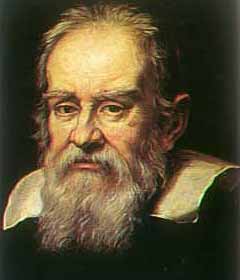|
Galileo Galilei was referred to, in his day, as the father of modern
astronomy, physics and science by various academics. One misconception
that has lasted many years is that Galileo Galilei invented the
telescope, which he did not. Galileo made improvements to the
telescope and was one of the first to improve it enough to use
it to observe the sky.
|
|
 Galileo Galilei
Galileo Galilei |
Galileo Galilei, using his improved telescope, on January 7,
1610 discovered four of Jupiter's largest satellites (Lo, Callisto,
Europa, and Ganymede). Galileo's observations of the moons of
Jupiter revolving around the large planet and Venus orbiting the
sun lent support to Copernicus' heliocentric theories.
Galileo also discovered that the Milky Way was made up of millions
of stars and that the Moon's surface was rough and cratered rather
than smooth as Aristotle had stated. Peering through his telescope,
Galileo also observed Neptune but did not recognize it as a planet
because it was much dimmer than Jupiter.
One of the most famous stories about Galileo is that he stood atop
the Leaning Tower of Pisa and dropped several balls of different
masses to show that the time of their descent was independent of
their mass. Air resistance was also taken into account in this experiment.
This story may or may not have been true, however. What is true
is that Galileo did rolls balls of different masses down an incline,
which proved the same thing.
Galileo Galilei was a Renaissance Man who also excelled in lute
playing and painting. He also attended medical school in Padua.
Galileo caused conflict within the church from his writings and
was forced to recant his views validating Copernicus' theories and
was placed under house arrest.
Galileo Galilei was born on February 15, 1564 in Pisa, Italy and
was the first child out of seven. Galileo died January 8, 1642 in
Arcetri.
Rumor has it …
Rumor has it that Galileo once measured the circumference of his
head then extrapolated the measurements to conclude the earth was
a gazillion miles in diameter.
In a totally misleading, unsubstantiated and blatantly false claim,
there was a document floating around claiming that Galileo preferred
wearing the tag on the outside of his underwear in order to prevent
chaffing.
Written by Kevin Lepton
|

